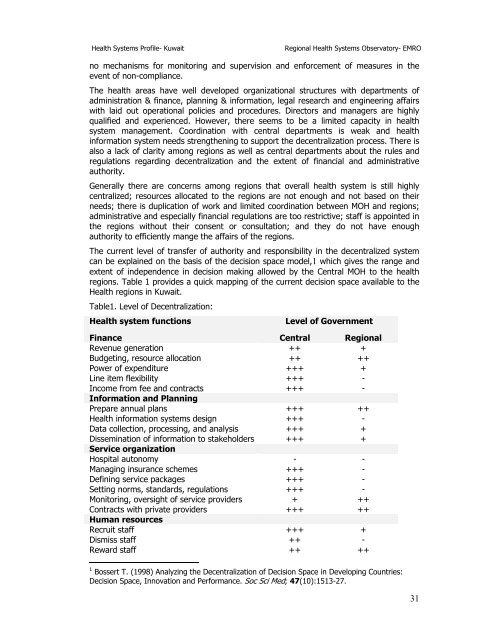Kuwait : Complete Profile - What is GIS - World Health Organization
Kuwait : Complete Profile - What is GIS - World Health Organization
Kuwait : Complete Profile - What is GIS - World Health Organization
Create successful ePaper yourself
Turn your PDF publications into a flip-book with our unique Google optimized e-Paper software.
<strong>Health</strong> Systems <strong>Profile</strong>- <strong>Kuwait</strong> Regional <strong>Health</strong> Systems Observatory- EMRO<br />
no mechan<strong>is</strong>ms for monitoring and superv<strong>is</strong>ion and enforcement of measures in the<br />
event of non-compliance.<br />
The health areas have well developed organizational structures with departments of<br />
admin<strong>is</strong>tration & finance, planning & information, legal research and engineering affairs<br />
with laid out operational policies and procedures. Directors and managers are highly<br />
qualified and experienced. However, there seems to be a limited capacity in health<br />
system management. Coordination with central departments <strong>is</strong> weak and health<br />
information system needs strengthening to support the decentralization process. There <strong>is</strong><br />
also a lack of clarity among regions as well as central departments about the rules and<br />
regulations regarding decentralization and the extent of financial and admin<strong>is</strong>trative<br />
authority.<br />
Generally there are concerns among regions that overall health system <strong>is</strong> still highly<br />
centralized; resources allocated to the regions are not enough and not based on their<br />
needs; there <strong>is</strong> duplication of work and limited coordination between MOH and regions;<br />
admin<strong>is</strong>trative and especially financial regulations are too restrictive; staff <strong>is</strong> appointed in<br />
the regions without their consent or consultation; and they do not have enough<br />
authority to efficiently mange the affairs of the regions.<br />
The current level of transfer of authority and responsibility in the decentralized system<br />
can be explained on the bas<strong>is</strong> of the dec<strong>is</strong>ion space model,1 which gives the range and<br />
extent of independence in dec<strong>is</strong>ion making allowed by the Central MOH to the health<br />
regions. Table 1 provides a quick mapping of the current dec<strong>is</strong>ion space available to the<br />
<strong>Health</strong> regions in <strong>Kuwait</strong>.<br />
Table1. Level of Decentralization:<br />
<strong>Health</strong> system functions Level of Government<br />
Finance Central Regional<br />
Revenue generation ++ +<br />
Budgeting, resource allocation ++ ++<br />
Power of expenditure +++ +<br />
Line item flexibility +++ -<br />
Income from fee and contracts +++ -<br />
Information and Planning<br />
Prepare annual plans +++ ++<br />
<strong>Health</strong> information systems design +++ -<br />
Data collection, processing, and analys<strong>is</strong> +++ +<br />
D<strong>is</strong>semination of information to stakeholders +++ +<br />
Service organization<br />
Hospital autonomy - -<br />
Managing insurance schemes +++ -<br />
Defining service packages +++ -<br />
Setting norms, standards, regulations +++ -<br />
Monitoring, oversight of service providers + ++<br />
Contracts with private providers +++ ++<br />
Human resources<br />
Recruit staff +++ +<br />
D<strong>is</strong>m<strong>is</strong>s staff ++ -<br />
Reward staff ++ ++<br />
1 Bossert T. (1998) Analyzing the Decentralization of Dec<strong>is</strong>ion Space in Developing Countries:<br />
Dec<strong>is</strong>ion Space, Innovation and Performance. Soc Sci Med; 47(10):1513-27.<br />
31
















